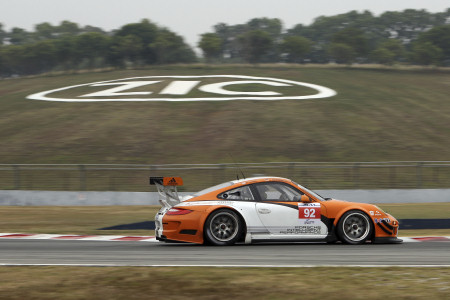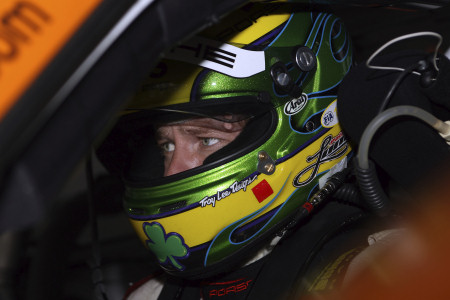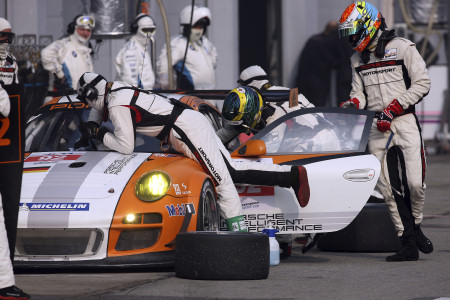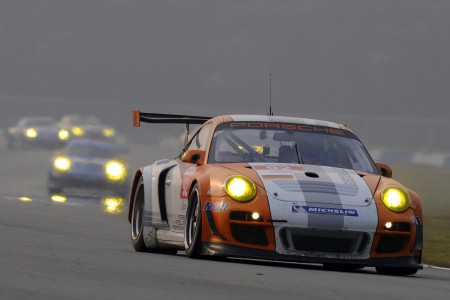The Way It Is/ Patrick Long on driving Porsche's hybrid 911 GT3 R
by Gordon Kirby Patrick Long's 2010 season came to a perfect close at the Zuhai 1,000Ks in China last month. Long and Joerg Bergmeister drove Porsche's factory 911 GT3 R hybrid to finish an excellent sixth overall, beating all the other GT cars. When the stored energy from the hybrid system is deployed it saves fuel enabling Porsche's hybrid to go much further on a load of fuel than a conventional car. As a result ALMS GT2 champions Long and Bergmeister were able to make one less pitstop with the hybrid than any conventional GT cars and finished three laps ahead of the GT class winner.
Patrick Long's 2010 season came to a perfect close at the Zuhai 1,000Ks in China last month. Long and Joerg Bergmeister drove Porsche's factory 911 GT3 R hybrid to finish an excellent sixth overall, beating all the other GT cars. When the stored energy from the hybrid system is deployed it saves fuel enabling Porsche's hybrid to go much further on a load of fuel than a conventional car. As a result ALMS GT2 champions Long and Bergmeister were able to make one less pitstop with the hybrid than any conventional GT cars and finished three laps ahead of the GT class winner.
"We ran quite a few laps longer than the other GT cars and that's one of the our big motivations with the hybrid," Long commented. "The Porsche Intelligent Performance concept is to be quicker and sleeker but to be more efficient at the same time. If we achieve that standard it's going to be hard for our competition and I think this was a good example because we made fewer pitstops than our competition.
"It was one of those weekends where everything goes so well that youre waiting for it to turn for the worst, but it never did. It only got better all the way down to the last lap."
Long last raced at Zuhai back in 1999 during his first year racing cars in the Elf La Filiere series and he reckoned the circuit layout would be ideal for Porsche's hybrid GT car.
"I was pretty confident and hopeful that the racetrack was going to suit us," Patrick said. "I had driven there during my year racing in the La Filiere series and I remember it being a handful of straightaways connected by hairpins. Thinking about the theoretical basis of the hybrid I knew it was going to be good for us.

© Porsche Cars
Long and Bergmeister were on the pace right away at Zuhai.
"I tested the car earlier in the year so I knew how the systems operated. I jumped in and within five laps we had begun our tests for the weekend. In the first couple of hours of practice we went straight to the top of the board and pretty much stayed there among all the GT cars. So it was a pretty seamless weekend from the start.
"Joerg has a huge amount of hours in the car from development and racing at the Nurburgring and I was pretty much the rookie. But I had plenty of laps by the end of the first day. I probably had five hours driving the car on the first day. I wad ready for bed that night."
A strong field of GT cars of all types (GT3, GT2, GT1 and the lone hybrid Porsche) showed up at Zuhai.
"There was a lot of competition among the GT cars and the times were very close," Long remarked. "There was quite an impressive field of GT competitors. It was a good roster and it was great to put the hybrid up against them."
Long and Bergmesiter shared the car equally during the race, both driving two stints.
"I think on pace we were pretty solid and also on consistency with tire wear," Long said. "Because we also use the front end to accelerate we stress the rear tires less which has sometimes been a challenge with us versus some of the mid-engine cars. On pace alone we had a good shot at it. But the dominance we enjoyed was aided mostly by the efficiency side.
"Like I say, it was a pretty seamless weekend. There were zero issues in the race. It made for a great weekend. To get the hybrid's first major victory and finsh ahead of all the other GT cars was mission accomplished. After the Nurburgring and Road Atlanta it was long-awaited."
Long says there was plenty of interest in the 911 GT3 R from both the fans and media during the Zuhai weekend.

© Porsche Cars
Patrick explained the technique required to get the best from the hybrid.
"As far as the driver is concerned you really emphasize late, hard braking," he observed. "You tune the car to change direction quickly so you can get straight as soon as possible coming out of the corner and let the hybrid's boost and the extra traction from the active all-wheel drive do its job.
"It's a pretty manageable transition from what I normally drive, which is a variation of the 911. There are a few different characteristics in driving the hybrid. I would say just knowing how to operate all the systems and the protocols with the engine is probably as big a transition as the actual physical driving of the car.
"There's more software engineering on the hybrid, of course. You've got traction control specialists, hybrid management men, and other guys working on the torque vectoring which has recently been added to the car. There's a lot of depth to it technically. I would say it's more than when I drove the RS Spyder for Roger (Penske). So on that side it's very intriguing, interesting and engaging. It's pretty humbling to be involved with this project because we're trying something new every single session."
Long takes pleasure from knowing that a talented, knowledgeable driver is still required to develop and get the best from a modern, fully-monitored racing car.
"It's almost reassuring that the driver still has quite a bit to say or suggest or offer opinions to many questions," Patrick remarked. "I'm sacred about the day when the engineers won't have any questions for us because the computer will be able to tell them everything. But so far, so good. There's still quite a bit of information that Joerg and I have to give them. There are plenty of debriefs and round table discussions and again, its really engaging and interesting."
The 911 GT3 R's automatic power boost system worked well in China. It provides a very useful boost of between 160-170 horsepower.
"With the auto-boost, the hybrid management system can utilize the charge that we've created in the brake zones in optimum places around the racetrack," Long said. "The engineers can predetermine those points on the track. It's very complicated on the software side but it's worked remarkably well. The software tells the hybrid system what the theoretical best places and times are to boost at different racetracks. I think that shows that the guys at Weissach know what they're doing. It's also a result of a lot of time on the test track."
It's important for the driver to be able to use the power boost whenever required.

© Porsche Cars
"You can also use it to help in an oversteer situation but mainly to help in traffic and to overtake other cars with a little bit of reserved boost that's not been utilized. Also, you might need a bit of boost in a defensive situation. Sometimes you can utilize the boost when you come out of the pits for example and you're on cold tires and want to maintain your position."
The on-demand power boost is operated by a small paddle located behind the left side of the steering wheel.
"With just a finger's worth of effort you can activate the boost," Patrick said. "It doesn't mean that when you pull the trigger that you're going to get the maxmum equivalent kilowatts in horsepower. It calculates what kind of scenario you're in as far as throttle and steering positions. It calculates that if you're in a hairpin it's not going to give you all of that boost.
"You can utilize the charge for as long as you are able to. You can use it for one second or five or seven seconds, which is the maximum charge. It's much different from the push-to-pass system that some other formulas have adopted. You can manipulate the system to use it pretty much for as long as you want and whenever you want."
Long is learning how to optimize the hybrid system.
"Harder, long brake zones are better because they create more time to charge," Patrick commented. "But I think the trick is to brake as late as possible and trust how good the car is on the brakes even though there's added weight. With the racing ABS system plus the hybrid system being active and slowing the car down separately from the brakes it means the car really does stop well.
"Part of it is going late enough into the brake zone to gain some room on your competition but also not overbraking in some of the higher speed corners where you might build too much momentum. So there are some subtle tricks, but most of it comes pretty naturally."
Porsche still has a lot to learn about maximizing the software.
"On the hardware side they're pretty much there in their potential," Long observed. "But I think on the software side it's still very much a project in motion. They're uncovering things all the time. One of the big things we worked on in Zuhai was running in the rain. You've got two brains communicating--an ECU and a hybrid management system measuring variables of wheel slip and how the traction control works in timing with the hybrid system becoming active.
"It gets very complicated and that's where we drivers have to relay to the engineers how we diagnose things and how we can make the system better to get the timing and unison working together between the front wheels and rear wheels as well as they can."
Long says the biggest difference from a regular racing 911 is getting the best from the 911 GT3 R's all-wheel drive system.
"As far as driving the hybrid, it's pretty similar," he said. "There aren't any huge fundamental differences in the high speed corners. It's very much similar. I think you have to manage the cambers and the geometry of the car. You have to pay very close attention to the front axle. It's not just about creating optimal grip through the front axle and geometry because it's a driving axle in the hybrid. So you have to watch tire temperatures and wear patterns because it's an active all-wheel drive a lot of the time."

© Porsche Cars
"With 40,000 rpm the charge and discharge creates a lot of heat," Long commented. "So we have to charge and discharge the flywheels coming in and out of any long pits stops during practice or whenever. Also, there are systems that allow us to charge the system quicker if we were under yellow or on a pace lap. There are a bunch of different variables and setting on how to charge and discharge the system.
"It's relatively warm inside the car," Patrick added. "The hybrid system definitely gives off quite a bit of heat but it's nothing thats noticeable. It is when you look at the telemetry but only by a few degrees. It's only a marginal increase in heat."
In October, Long enjoyed his first trip to Australia for the Surfers Paradise V8 Supercar race. He was one of a group of a dozen overseas drivers invited down for the weekend. Patrick co-drove with Mike Caruso in a Holden Commodore run by Garry Rogers Motorsports. They finished fourth in the first race when Long was the highest-placed overseas driver and were eleventh in the second race after a flat tire.
"It was a great trip from beginning to end," Patrick grinned. "I was thoroughly impressed with the Australian drivers and teams and also the organization from the promotion to the officiating. It was very impressive and great to see what a national series could do. I loved driving the car. I felt a very natural connection to the car. The biggest challenge for me was learning the racetrack in short order with limited laps as the second driver.
"But it all came together in the race. When you're the second-string driver you don't feel the car in racetrim until you get into the race. So I didn't really know what to expect. But Saturday's race went well. I led for quite a while and we came out with fourth overall. The second day was a bit longer because I had a flat tire and went a lap down. But I was able to overcome that and get back on the lead lap and hand it over to Mike."
Long enjoyed the atmosphere, crowd and hanging-out with the other overseas drivers.
"It was just a fun weekend," Patrick said. "They had 170,000 people for the weekend. I was impressed. It was a great crowd and it was great how the overseas drivers travelled together and helped promote the event together. It was a good group of guys. We all stayed out of trouble and had a good time."
"I had never been to Australia and I hope to get back there soon. I think those cars are a great formula. There are limited driver aids, tall tires, big horsepower and a good amount of handling and engineering in the cars. It has some of the things I love about the big, heavy stock cars and a lot of the things I love about the current, modern GT cars. I find those cars to be somewhere in between."
Before Thanksgiving Long shook down next year's fleet of Grand-Am Porsche 911 GT2 cars for Porsche North America. On December 1st and 2nd he will test a Porsche-powered Daytona prototype at Homestead and may do some of next year's Grand-Am endurance races. Long hopes to test and race the 911 GT3 R hybrid again in 2011 but he and co-driver Bergmeister's primary job will be defending their ALMS GT2 title with Seth Neiman's Flying Lizard team.
"I couldn't have a better job," Patrick grinned. "Working for Porsche and Flying Lizard is a dream come true."
Auto Racing ~ Gordon Kirby
Copyright 2010 ~ All Rights Reserved
Copyright 2010 ~ All Rights Reserved
Top of Page